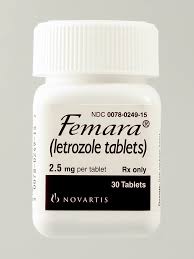Eva Costantini
LETROZOLE AS ADJUVANT THERAPY FOR POST-MENOPAUSAL WOMEN WITH ENDOCRINE-RESPONSIVE EARLY BREAST CANCER

The growth of some breast cancers is stimulated or maintained by estrogens. Treatment of breast cancer thought to be hormonally responsive has included a variety of efforts to decrease estrogen levels or inhibit estrogen effects. These interventions lead to decreased tumor mass or delayed progression of tumor growth in some women.
The usual endocrine (anti-estrogen) therapy for hormone receptor-positive breast cancer is Tamoxifen, an antagonist of the estrogen receptor in breast tissue via its active metabolite, hydroxytamoxifen. Tamoxifen is currently used for the treatment of both early and advanced ER+ (estrogen receptor positive) breast cancer in pre- and post-menopausal women. There is good evidence that Tamoxifen may prevent, or at least delay, the onset of the disease in women at high risk. It also prevents relapse in patients who receive it in the postoperative adjuvant setting: women who took this drug for 5 years showed a reduction in diagnosis of invasive breast cancer.
Tamoxifen is not a panacea, however, and a number of studies have been carried out over the years in order to develop alternative therapies. In fact, hormone-sensitive breast cancer can be regarded as a chronic disease with a persistent risk of escape from effective endocrine control. Activation of growth factor signaling pathways has been implicated in progression of HR+ breast cancer to an estrogen-independent phenotype and the development of resistance to endocrine therapy, particularly Tamoxifen. It has been hypothesized that combining endocrine therapy with targeted signal transduction inhibitors may circumvent hormone-independent signaling pathways, so that patients may experience prolonged disease control.
An adjuvant treatment option for women with early-stage breast cancer is represented by Aromatase Inhibitors, like Letrozole (Femara®). This one may be more effective than Tamoxifen for patients with tumor profiles associated with a high risk of developing hormone resistance (e.g., tumors with HER2 gene amplification) and represents an ideal combination partner for agents that inhibit growth signaling pathways implicated in hormone resistance.

Although AIs and Tamoxifen both help to prevent the growth of estrogen-sensitive breast tumors, they work differently in the body: Tamoxifen blocks the tumor’s ability to use estrogen by interfering with its receptor, while AIs reduce the amount of estrogen in the body.
DESCRIPTION

Letrozole (Femara®) is an oral non-steroidal aromatase inhibitor for the treatment of hormonally-responsive breast cancer after surgery, chemically described as 4,4'-(1H-1,2,4-Triazol-1-ylmethylene)dibenzonitrile. It is a white to yellowish crystalline powder, practically odorless, freely soluble in dichloromethane, slightly soluble in ethanol, and practically insoluble in water. It has a molecular weight of 285.31, empirical formula C17H11N5, and a melting range of 184°C-185°C.
Femara (letrozole tablets) is available as 2.5 mg tablets for oral administration.
MECHANISM OF ACTION
Letrozole belongs to Aromatase Inhibitors, a form of hormone therapy which works by reducing the amount of estrogen produced in the bodies of post-menopausal women.
Aromatase is an enzyme responsible for a key step in the biosynthesis of estrogens. It is a member of the cytochrome P450 superfamily, which are monooxygenases that catalyze many reactions involved in steroidogenesis. In particular, aromatase is responsible for the aromatization of androgens into estrogens (specifically, it transforms androstenedione to estrone and testosterone to estradiol). These steps include three successive hydroxylations of the 19-methyl group of androgens, followed by simultaneous elimination of the methyl group as formate and aromatization of the A-ring.

In post-menopausal women, estrogens are mainly derived from the action of the aromatase enzyme. The suppression of estrogen biosynthesis in peripheral tissues and in the cancer tissue itself can therefore be achieved by specifically inhibiting the aromatase enzyme.
Letrozole prevents the aromatase from producing estrogens by competitive, reversible binding to the heme of its cytochrome P450 subunit: the result is a reduction of estrogen biosynthesis in all tissues. The action is specific (Letrozole selectively inhibits gonadal steroidogenesis) and has no significant effect on adrenal mineralocorticoid or glucocorticoid synthesis. It doesn’t affect synthesis of thyroid hormones either.
PHARMACOKINETICS
Letrozole is rapidly and completely absorbed from the gastrointestinal tract and absorption is not affected by food. It is metabolized slowly to an inactive metabolite whose glucuronide conjugate is excreted renally, representing the major clearance pathway.
About 90% of radiolabeled Letrozole is recovered in urine.
Letrozole’s terminal elimination half-life is about 2 days and steady-state plasma concentration after daily 2.5 mg dosing is reached in 2-6 weeks. Plasma concentrations at steady-state are 1.5 to 2 times higher than predicted from the concentrations measured after a single dose, indicating a slight non-linearity in the pharmacokinetics of Letrozole upon daily administration of 2.5 mg. These steady-state levels are maintained over extended periods, however, and continuous accumulation of Letrozole does not occur.
Letrozole is weakly protein bound and has a large volume of distribution (approximately 1.9 L/kg).
PHARMACODYNAMICS
In post-menopausal patients with advanced breast cancer, daily doses of 0.1 mg to 5 mg Femara suppress plasma concentrations of estradiol, estrone, and estrone sulfate by 75%-95% from baseline with maximal suppression achieved within two-three days.
Suppression is dose-related, with doses of 0.5 mg and higher giving many values of estrone and estrone sulfate that were below the limit of detection in the assays.
Estrogen suppression was maintained throughout treatment in all patients treated at 0.5 mg or higher.
No changes were noted in plasma concentrations of androgens (androstenedione and testosterone) among healthy post-menopausal women after 0.1, 0.5, and 2.5 mg single doses of Femara or in plasma concentrations of androstenedione among post-menopausal patients treated with daily doses of 0.1 mg to 5 mg. This indicates that the blockade of estrogen biosynthesis does not lead to accumulation of androgenic precursors.
Plasma levels of LH and FSH were not affected by Letrozole in patients, nor was thyroid function as evaluated by TSH levels, T3 uptake, and T4 levels.
SIDE EFFECTS
Adjuvant treatment with Letrozole results in a reduced risk of developing recurrent disease, and it also helps to lower the risk of a second new breast cancer in the opposite breast.
Unfortunately this therapy has also a number of side effects, which can be more or less severe and are reported in about 1/3 of the women who are taking the drug.
Most common side effects are:
- hot flashes
- fatigue or weakness
- nausea
- increased sweating
- loss of bone mineral density (BMD), which can lead to osteoporosis.
Occasionally patients may report other problems, such as painful joints, dizziness, headaches, skin rashes, night sweats, constipation, weight gain, diarrhoea.
Anyway, these side effects are often predictable in terms of their onset and duration, are generally reversible and are supposed to go away after treatment is complete.
Finally there is no relationship between the presence or severity of side effects and the effectiveness of the medication.
Tamoxifen, Letrozole or both?
The American Society of Clinical Oncology (ASCO) recommends that post-menopausal women with hormone-sensitive breast cancer consider one of two adjuvant treatment options:
1) Begin treatment with Tamoxifen for 2 to 3 years or 5 years, and then switch to an AI for another 2 to 3 years or 5 years.
2) Forego Tamoxifen entirely and begin adjuvant treatment with an AI for 5 years.
ASCO concluded that AIs are appropriate as initial treatment for women who should not take Tamoxifen, and that patients who cannot take AIs should receive Tamoxifen.
Whether an individual patient should start therapy with an AI or begin therapy with Tamoxifen and then change to an AI is a subject of medical judgment and clinical research. Patients should talk with their doctors about which drug would be best for them given their particular medical situation.
LEtrozole Adjuvant therapy Duration (LEAD) study
LEAD study (official title: “Letrozole Adjuvant Therapy Duration (LEAD) Study: Standard Versus Long Treatment. A Phase III Trial in Post-Menopausal Women with Early Breast Cancer.”) is being currently carried out in Italy, sponsored by GIM (Gruppo Italiano Mammella).
The primary objective of this study is to compare the Disease-Free Survival (DFS) of previously treated, post-menopausal women with early-stage breast cancer treated with standard- (2-3 years of Tamoxifen followed by 2-3 years of Letrozole) versus long-treatment (2-3 years of Tamoxifen followed by 5 years of Letrozole) adjuvant Letrozole.
This study is also meant to compare the Overall Survival (OS) of these patients, and their Safety.
Patients in this study (post-menopausal women who received adjuvant Tamoxifen for at least 2 years but no more than 3 years and 3 months) are randomized to 1 or 2 treatment arms:
- Arm I (standard treatment): Patients previously treated with Tamoxifen for 2 years receive Letrozole for an additional 3 years and those previously treated with Tamoxifen for 3 years receive Letrozole for an additional 2 years, so the total duration of the endocrine treatment is 5 years.
- Arm II (long treatment): Patients receive Letrozole for an additional 5 years regardless of the duration of the previous Tamoxifen treatment, so the total duration of the endocrine treatment is 7-8 years.
For further information, see National Cancer Institute
Letrozole and the future

Long-term estrogen deprivation treatment for breast cancer can, in some patients, lead to the activation of alternate cellular pathways, resulting in the re-emergence of the disease; moreover, hormone therapy-sensitive breast tumors may develop resistance and progress to a hormone-independent state.
For these reasons, recent studies focus on novel combination therapies in order to provide enhanced efficacy or overcome treatment resistance. In fact the proliferative, invasive, and metastatic potential of breast tumors may be largely predetermined at an early stage in the course of disease, whilst genetic alterations that accumulate during progression from in situ to metastatic disease are unpredictable and result in specific phenotypic changes and loss of sensitivity to treatments.
Letrozole, one of the most potent aromatase inhibitors, is the ideal candidate for combination therapy: it can be used in combination strategies with agents targeting other growth factor pathways. It is one of the most intensively studied aromatase inhibitors in the evolving combinatorial setting, in fact detecting its responsive targets can help to understand how the use of this drug can be tailored more efficiently to specific patient needs.
Tailoring therapy to individual patient profiles (clinical, histologic, pathologic, and genetic) will become more sophisticated in the future, helping to maximize the benefits of endocrine therapy throughout the breast cancer continuum; Letrozole will undoubtedly become an integral part of the next generation of tailored combination regimens for the treatment of breast cancer.
For further information, see:
Femara® and the future: tailoring treatment and combination therapies with Femara
Matthew Ellis and Cynthia Ma
